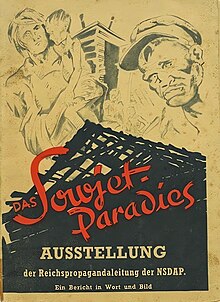The Soviet Paradise
| The Soviet Paradise | |
|---|---|
 Promotional poster for the exhibition | |
| German | Das Sowjet-Paradies |
| Directed by | Friedrich Albat |
Release date |
|
Running time | 14 minutes |
| Country | Nazi Germany |
| Language | German |
The Soviet Paradise (German original title "Das Sowjet-Paradies") was the name of an exhibition and a propaganda film, which was organized by the Reichspropagandaleitung (Department of Film of NSDAP) of the Nazi Party and was displayed in the larger cities of the Reich and occupied countries: Vienna, Prague, Berlin and others. Its goal was to show "poverty, misery, depravity and need" of the nations in the Soviet Union under Jewish Bolshevist rule and thus to justify the war against the Soviet Union. The accompanying guide for the exhibition noted, "The present Soviet state is nothing other than the realization of that Jewish invention".[1]
The exhibition included entire households with its contents, transported from the Eastern Front, on display.[2] The exhibition contained images of firing-squads and bodies of young girls, some still children, who had been hung and were dangling from ropes.[3]
From 8 May[4] to 21 June 1942, the exhibition was in the Lustgarten in Berlin and according to official information 1.3 million people visited the show. On May 18 a Jewish-Communist resistance group called "Baum-Group" organized an arson attack, which caused only a small amount of damage. At least Herbert Baum and Marianne Baum and over 30 other people were arrested and executed.[5] A short propaganda film was created to supplement the exhibition.
External links[]
References[]
- ^ A partial English translation of a brochure from the exhibit, accessed August 2018
- ^ "'Soviet Paradise' On Show During Nazi Nightmare". RadioFreeEurope/RadioLiberty. Retrieved 2020-12-07.
- ^ Nelson, Anne (2009). Red Orchestra. The Story of the Berlin Underground and the Circle of Friends Who Resisted Hitler. New York: Random House. p. 255. ISBN 978-1-4000-6000-9.
- ^ Kallis, A (16 December 2005). Nazi Propaganda and the Second World War. Springer. p. 80. ISBN 9780230511101.
- ^ Granata, Cora Ann; Koos, Cheryl A. (2008). The human tradition in modern Europe, 1750 to the present. Rowman & Littlefield. p. 150. ISBN 978-0-7425-5411-5.
- 1941 films
- German-language films
- Nazi works
- 1942 films
- Anti-communism in Germany
- Nazi propaganda